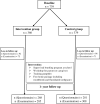One-year oral health outcome of a community-based trial in schoolchildren aged 6-7 years old in Tehran, Iran
- PMID: 37083658
- PMCID: PMC10120929
- DOI: 10.1371/journal.pone.0284366
One-year oral health outcome of a community-based trial in schoolchildren aged 6-7 years old in Tehran, Iran
Abstract
Promoting schoolchildren's oral health is important, particularly in developing countries. This study was conducted to monitor the oral health of schoolchildren aged 6-7 years old following the implementation of an oral health promotion program in Tehran, Iran. The protocol was registered in the Iranian Registry of Clinical Trials (Code: IRCT20090307001749N4). A cluster random sampling method was applied, and the schools were randomly allocated to intervention and control groups. An intervention package consisting of a one-day workshop for parents and supervised toothbrushing for children was employed. In both groups, the Caries Assessment Spectrum and Treatment (CAST) and Oral Hygiene Index Simplified (OHI-S) were evaluated at baseline and at one-year follow-up in addition to the questionnaire data. Clinical data were collected by calibrated examiners at both intervals (Kappa = 89.8%, 87.68%) and analyzed using the SPSS software ver. 22.0. Of 739 children included at baseline, 593 were re-examined after one year (response rate = 74%). According to the Generalized Estimating Equation (GEE) analysis, considering the confounding effect of time, significantly more children in the control group had deciduous molars with a score of 3 and higher compared to the intervention group (OR = 1.79; 95% CI:1.17-2.73, p = 0.007). The oral hygiene status of the children significantly improved in the intervention group compared to the controls (B = -0.27; 95% CI: -0.45 --0.08, p = 0.005). After one year, the improvement in the oral health-related attitude of parents and children's oral health behavior was marginally significant in the intervention group compared to the control group [0.2 (0.17) vs. -0.13 (0.05), p = 0.096] and [0.06 (0.06) vs. -0.05 (0.04), p = 0.09], respectively. However, the impact on the oral health-related knowledge and self-reported behavior of the parents was not significant. In the intervention group, children had less caries and a better oral hygiene status compared to the controls after one year.
Copyright: © 2023 Babaei et al. This is an open access article distributed under the terms of the Creative Commons Attribution License, which permits unrestricted use, distribution, and reproduction in any medium, provided the original author and source are credited.
Conflict of interest statement
The authors have declared that there is no competing interests.
Figures




Similar articles
-
Oral health of 6-7 year-old children according to the Caries Assessment Spectrum and Treatment (CAST) index.BMC Oral Health. 2019 Jan 17;19(1):20. doi: 10.1186/s12903-018-0709-x. BMC Oral Health. 2019. PMID: 30654779 Free PMC article.
-
Effect of an Oral Health Promotion Program Including Supervised Toothbrushing on 6 to 7-Year-Old School Children: A Randomized Controlled Trial.Front Dent. 2020 Aug;17(19):1-9. doi: 10.18502/fid.v17i19.4313. Epub 2020 Aug 30. Front Dent. 2020. PMID: 33615295 Free PMC article.
-
Caries incidence of the first permanent molars according to the Caries Assessment Spectrum and Treatment (CAST) index and its determinants in children: a cohort study.BMC Oral Health. 2021 May 13;21(1):259. doi: 10.1186/s12903-021-01612-1. BMC Oral Health. 2021. PMID: 33985489 Free PMC article.
-
Community-based population-level interventions for promoting child oral health.Cochrane Database Syst Rev. 2016 Sep 15;9(9):CD009837. doi: 10.1002/14651858.CD009837.pub2. Cochrane Database Syst Rev. 2016. Update in: Cochrane Database Syst Rev. 2016 Dec 22;12:CD009837. doi: 10.1002/14651858.CD009837.pub3. PMID: 27629283 Free PMC article. Updated. Review.
-
Oral health promotion through health-promoting schools in developing countries: A scoping review.Community Dent Oral Epidemiol. 2023 Dec;51(6):1197-1208. doi: 10.1111/cdoe.12864. Epub 2023 Apr 14. Community Dent Oral Epidemiol. 2023. PMID: 37057747
References
Publication types
MeSH terms
Associated data
LinkOut - more resources
Full Text Sources
Medical
Miscellaneous

